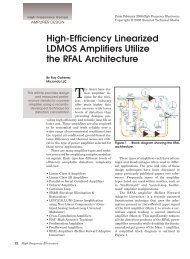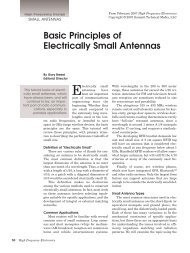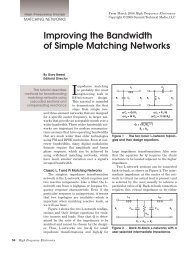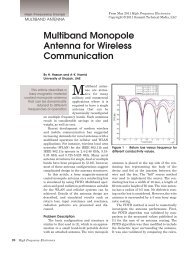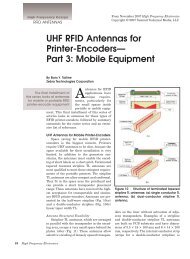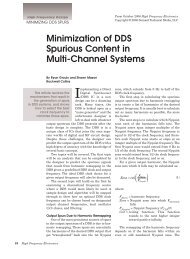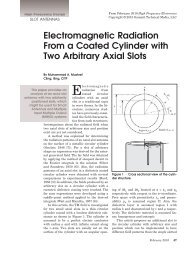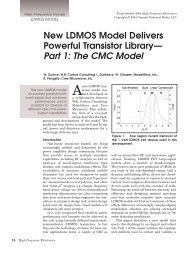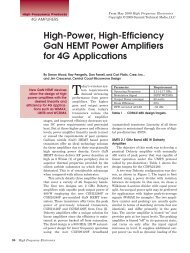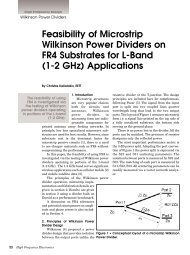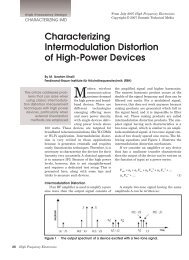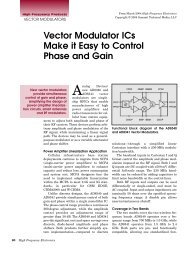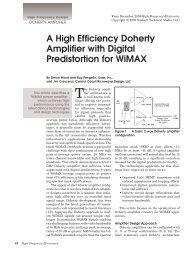The Future of Instrumentation - High Frequency Electronics
The Future of Instrumentation - High Frequency Electronics
The Future of Instrumentation - High Frequency Electronics
Create successful ePaper yourself
Turn your PDF publications into a flip-book with our unique Google optimized e-Paper software.
Figure 4 • <strong>The</strong> NI PXIe-5644R is the world’s first s<strong>of</strong>twaredesigned<br />
instrument.<br />
However, even with all this flexibility, there is <strong>of</strong>ten a<br />
need for more. For example, many new tests require<br />
capabilities like frequency domain triggering, real-time<br />
spectral masks and embedded control algorithms. <strong>The</strong>se<br />
tasks can be difficult to execute as they are required to be<br />
directly executed within the instrument’s embedded firmware<br />
and typically must be implemented by the vendor.<br />
Fortunately, there is a new paradigm in instrumentation<br />
called s<strong>of</strong>tware-designed instruments that opens up the<br />
instrument’s firmware and allows the engineer complete<br />
access to add their required functionality.<br />
<strong>The</strong> first instrument to support this paradigm is the<br />
NI PXIe-5644R vector signal transceiver (Figure 4).<br />
Combining a vector signal analyzer, a vector signal generator<br />
and high-speed digital I/O in one three-slot PXI<br />
module, the NI PXIe-5644R vector signal transceiver is a<br />
fraction <strong>of</strong> the size and cost <strong>of</strong> traditional solutions while<br />
maintaining industry-leading measurement performance.<br />
What makes it a s<strong>of</strong>tware-designed instrument is that is<br />
has an open, user-programmable FPGA at its core. Users<br />
can modify its s<strong>of</strong>tware and firmware, which is based on<br />
LabVIEW, to create an instrument specific to their needs.<br />
Out <strong>of</strong> the box, the vector signal transceiver provides a<br />
s<strong>of</strong>tware experience similar to other instruments with a<br />
quick time to first measurement/generation and a programming<br />
interface for the most common functions.<br />
However, the true power comes from the fact that all<br />
LabVIEW s<strong>of</strong>tware and firmware source code is provided<br />
to enable users to modify their instruments to their specific<br />
needs. System design s<strong>of</strong>tware like LabVIEW is well<br />
suited to s<strong>of</strong>tware designed-instruments because it is<br />
capable <strong>of</strong> abstracting the processing implemented on an<br />
FPGA and the microprocessor on the PXI controller in a<br />
way that does not require extensive knowledge <strong>of</strong> computing<br />
architectures and data manipulation. This frees the<br />
user to focus on the functionality <strong>of</strong> algorithms and instrument<br />
control to meet their specific application needs.<br />
Qualcomm Atheros is one <strong>of</strong> the initial users <strong>of</strong> the<br />
s<strong>of</strong>tware-designed vector signal transceiver in the testing<br />
<strong>of</strong> their latest 802.11ac WLAN transceiver. <strong>The</strong>y were<br />
faced with the challenge <strong>of</strong> their latest designs having<br />
multiple gain settings at each stage <strong>of</strong> the radio structure.<br />
This resulted in hundreds <strong>of</strong> thousands <strong>of</strong> data points that<br />
needed to be acquired for a single operational mode. Using<br />
traditional instruments it was not feasible to perform all<br />
these measurement and instead used a best estimate gain<br />
table that would only produce approximately 40 meaningful<br />
data points per iteration. However, after making the<br />
switch to the vector signal transceiver, they were able to<br />
Figure 5 • Qualcomm Atheros realized a 200 times improvement in measurement speed and a better<br />
understanding <strong>of</strong> their devices after making the switch to the vector signal transceiver.<br />
25



